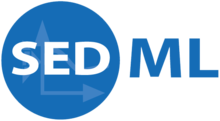|
SED-ML
The Simulation Experiment Description Markup Language (SED-ML) is a representation format, based on XML, for the encoding and exchange of simulation descriptions on computational models of biological systems.[1] It is a free and open community development project. SED-ML Level 1 Version 1,[2] the first version of SED-ML, enables descriptions of time course simulation experiments. StructureThe SED-ML format is built of five major blocks:
More information on the SED-ML structure is available from the SED-ML home page[1] and the reference publication.[3] HistoryThe idea of developing a standard format for simulation experiment encoding was born at the European Bioinformatics Institute (EMBL-EBI). In 2007, Dagmar Waltemath and Nicolas Le Novère started to draft such a format during Dagmar's Marie-Curie funded internship in the Computational Neuroscience group at EMBL-EBI.[4] The SED-ML project was first discussed publicly at the 12th SBML Forum Meeting in 2007, in Long Beach (US). The first version of SED-ML was then presented at the "Super-hackathon "standards and ontologies for Systems Biology"" in Okinawa in 2008. Back then, the language was called MIASE-ML (in accordance with the MIASE guidelines). In Okinawa, many researchers showed a high interest in the format, and discussions were vital. MIASE became the Minimum Information guideline for simulation experiments. MIASE-ML was renamed into "Simulation Experiment Description Markup Language" (SED-ML). Level 1 Version 1 of SED-ML officially appeared in March 2011, but SED-ML was presented, discussed and further specified during several community meetings in the years in between, including the combined "CellML-SBGN-SBO-BioPAX-MIASE workshop" in 2009, or the "2010 SBML-BioModels.net Hackathon". Since then SED-ML has been developed in collaboration with the communities forming the "computational modeling in biology network" COMBINE. Besides dedicated sessions at various meetings, the development of SED-ML benefits from community interactions on the SED-ML-discuss mailing list.[5] SED-ML CommunitySED-ML is part of the COmputational Modeling in Biology Network (COMBINE). Format development is coordinated by an editorial board elected by the community.[6] Discussions take place at SED-ML-discuss.[5] References
|
||||||||||||||||
